Key takeaways:
- Active engagement of quieter participants enhances inclusivity and fosters richer discussions.
- Utilizing anonymous feedback and real-time polling encourages honest responses and lively interactions.
- Establishing ground rules and using breakout sessions can create safe spaces for open communication and amplify diverse voices.
- Championing participant voices leads to innovative outcomes and strengthens community bonds among attendees.
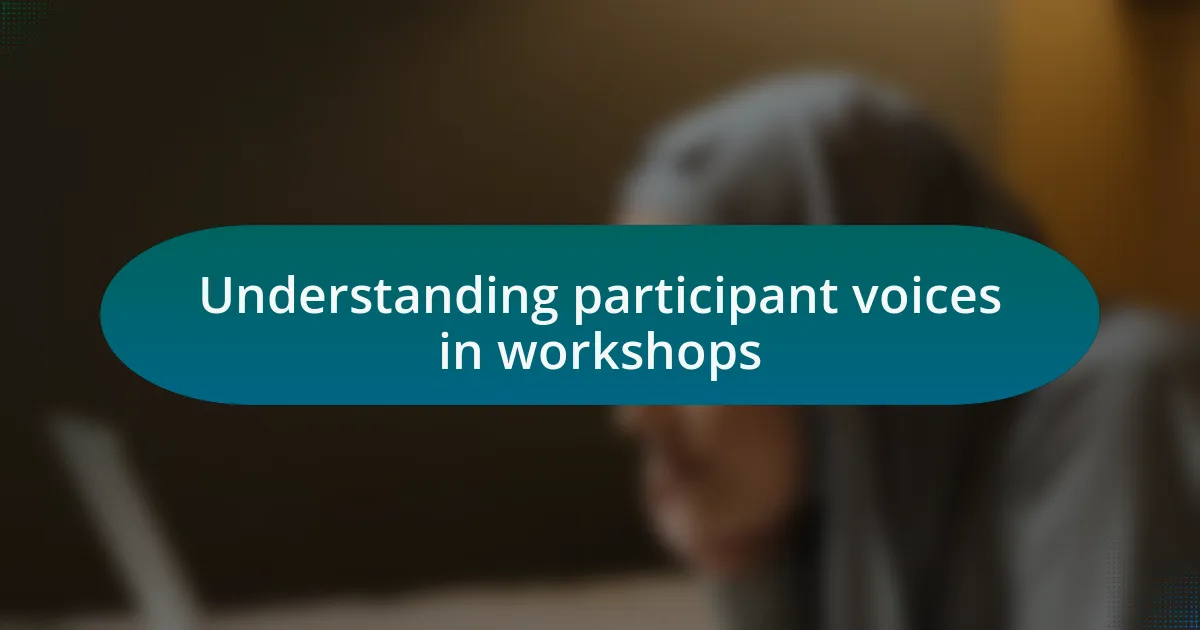
Understanding participant voices in workshops
Understanding participant voices in workshops is crucial for fostering an inclusive environment. I once attended a workshop where, despite a well-crafted agenda, a few voices dominated the conversation. It made me realize how vital it is to actively engage quieter participants—those who may hold valuable insights but hesitate to speak up.
I often find that listening isn’t just about hearing words; it’s about interpreting feelings. During a session I facilitated, one participant shared how previous experiences in workshops left her feeling undervalued. That moment resonated deeply with me, highlighting the emotional weight behind voices that are often overlooked. How can we create spaces where everyone feels empowered to contribute meaningfully?
The diversity of participant voices adds richness to the dialogue in any workshop. I remember a time when a simple icebreaker led to unexpected connections among attendees. It made me think: what if we structured workshops to prioritize these interactions? By embedding opportunities for shared stories, we unlock a treasure trove of perspectives that enhance the learning experience for everyone involved.
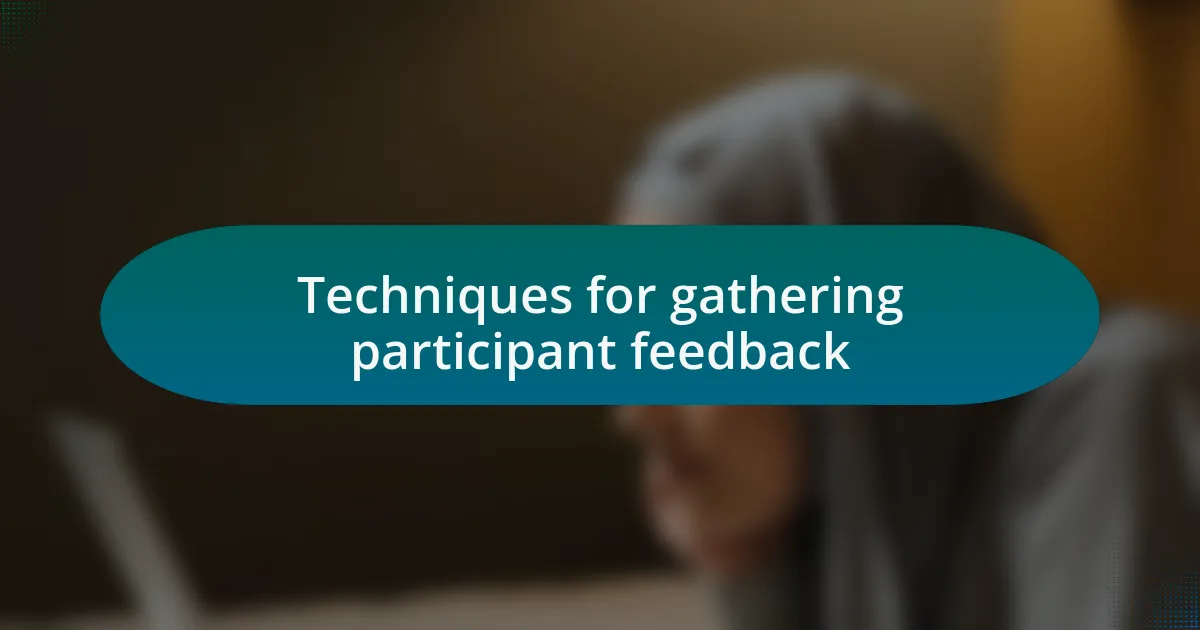
Techniques for gathering participant feedback
Gathering participant feedback can take many forms, and I’ve found that using anonymous surveys often encourages more honest responses. In one workshop I hosted, we implemented a simple digital feedback tool that allowed attendees to express their thoughts privately. The insights garnered from that survey revealed underlying concerns about pacing, prompting me to adjust future sessions to accommodate everyone’s learning styles.
Another technique that works marvelously is real-time polling. I vividly recall a session where we used live polls to gauge participants’ opinions on different topics as we progressed. The immediate feedback not only helped steer the conversation but also energized the group, making everyone feel their voices were being heard in the moment. I often wonder how many facilitators miss out on such dynamic engagement strategies.
Additionally, inviting participants to share their feedback verbally in a roundtable format can be powerful. I once joined a workshop where the facilitator directly encouraged each person to speak without interruption, creating a safe space for all voices. This technique not only made individuals feel valued, but it also sparked lively discussions, making it clear that every opinion mattered. How often do we prioritize such intentional structures to amplify participant voices?
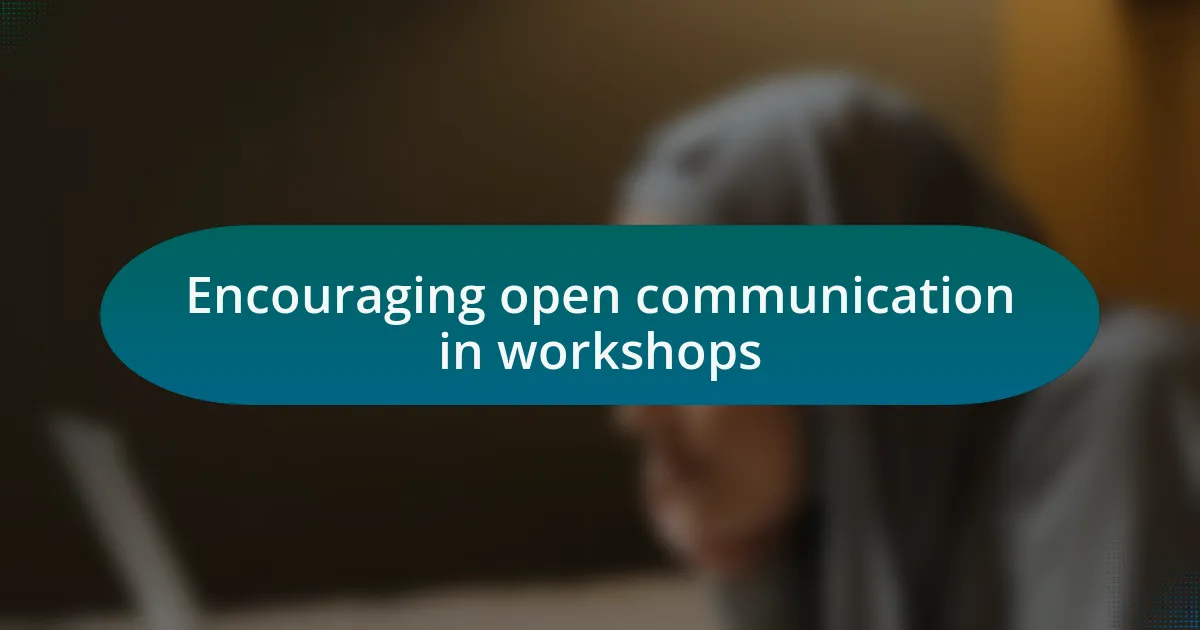
Encouraging open communication in workshops
Creating an atmosphere of open communication in workshops isn’t just beneficial; it’s essential. During one particularly memorable workshop, I decided to start with an icebreaker that encouraged everyone to share a personal story related to the topic at hand. The energy in the room shifted as participants began to connect on a deeper level, fostering trust that made them more willing to voice their thoughts throughout the session. Have you ever witnessed how a simple story can unravel barriers between people?
In my experience, transparency is another key element to encourage dialogue. I often share my own challenges and failures related to the workshop subject. When I opened up about a project I struggled with, attendees not only sympathized but also felt empowered to share their own missteps, paving the way for a richer conversation. How refreshing it is when people realize they are not alone in facing challenges!
Establishing ground rules can also set the tone for open communication. I remember a workshop where we collectively agreed on no interruptions during discussions. This simple rule transformed our interactions, allowing deep dives into ideas and preventing dominant voices from overshadowing others. I often think about the power of such agreements—are we doing enough to create spaces where everyone feels they have a right to speak?
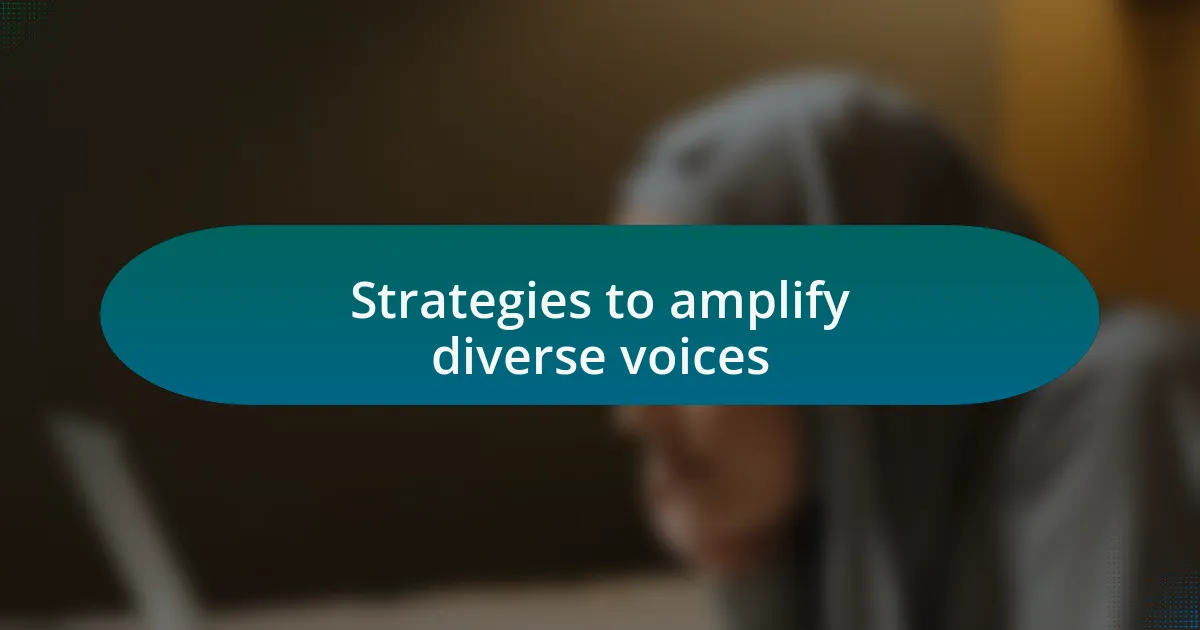
Strategies to amplify diverse voices
A powerful strategy I’ve found effective is using breakout sessions. In one workshop, I divided participants into small groups and tasked them with brainstorming on a specific problem. The intimacy of these smaller settings allowed quieter voices to emerge; many later expressed feeling more comfortable sharing ideas where they weren’t competing with louder participants. Have you ever experienced that shift when the setting changes?
Another method I’ve employed is actively encouraging questions. I remember a workshop where, after an expert spoke, I paused and invited everyone to ask anything they wanted. It was during that moment of silence that a participant timidly raised a hand, sparking a chain reaction of inquiries that caused a ripple effect of engagement. It’s fascinating how a mere invitation can unlock a treasure trove of insights, don’t you think?
Lastly, employing anonymous feedback can work wonders in amplifying diverse perspectives. During a recent event, I utilized digital tools that allowed participants to voice their thoughts without fear of judgment. I was amazed at the wealth of opinions that flowed in, many of which challenged the norm and prompted deeper discussions. It’s incredible how anonymity can serve as a liberating force for expression—how often do we underestimate the reluctance of others to speak up?
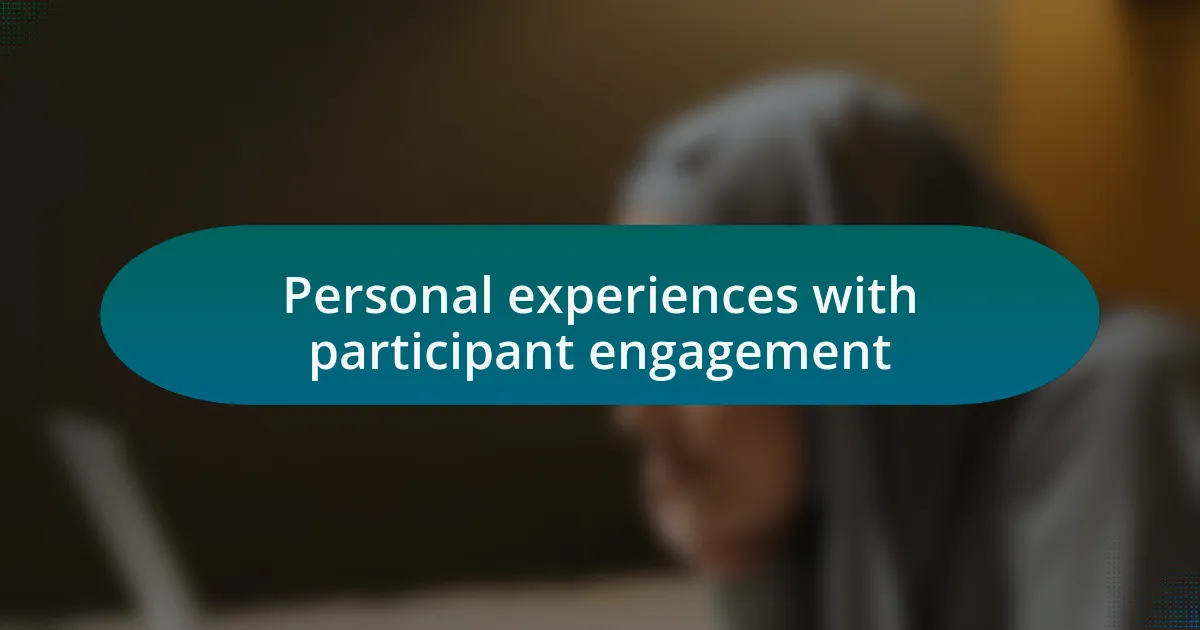
Personal experiences with participant engagement
Engaging participants is often a delicate dance of understanding and intuition. I recall a time when a participant who usually remained silent surprised everyone by sharing a profound insight during a group discussion. It struck me how a simple shift in my body language—leaning in and making direct eye contact—encouraged them to express themselves. Have you ever seen the transformation in someone when they feel truly seen and heard?
In another workshop, I introduced collaborative tools like online whiteboards, which allowed participants to express their thoughts visually. I vividly remember the moment when one individual, usually shy, created an entire mind map that not only reflected their ideas but ignited others to add their thoughts in real-time. How exhilarating it is to witness a participant’s confidence bloom through creative expression!
Another experience that stands out involves using role-playing scenarios to simulate real-world challenges. I facilitated a session where participants stepped into various roles, and the energy in the room shifted dramatically. Suddenly, those who typically held back became animated and engaged, sharing perspectives they hadn’t previously dared to voice. What I learned from this was striking: sometimes, stepping outside of our comfort zones opens the door to profound dialogues.
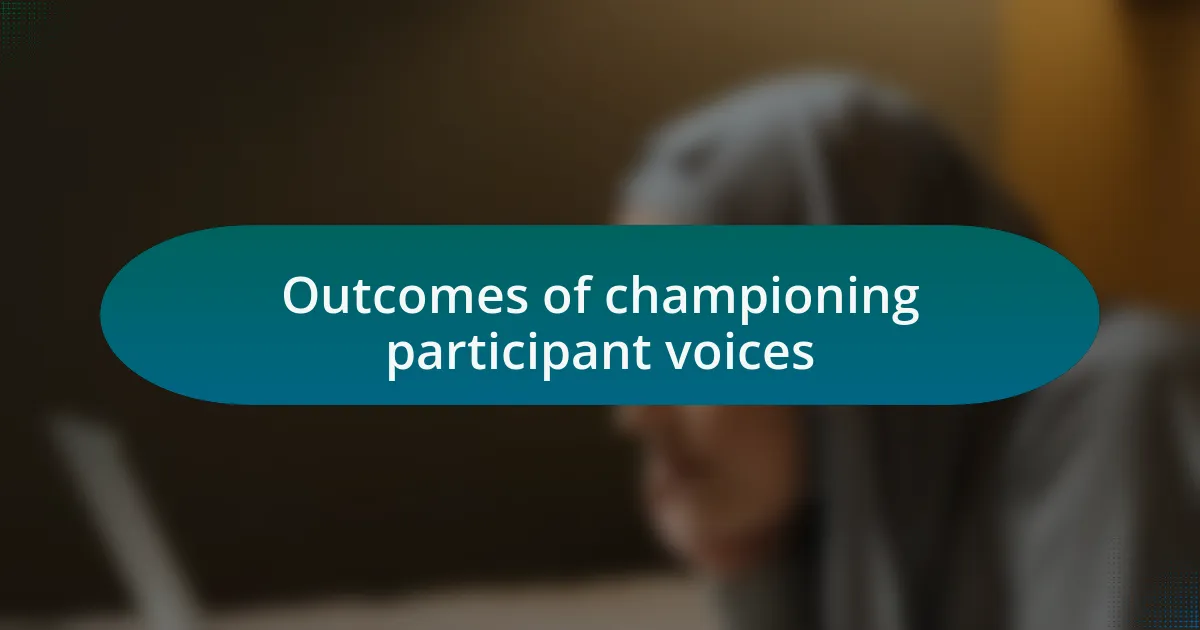
Outcomes of championing participant voices
Championing participant voices leads to dynamic and meaningful outcomes. I’ve seen firsthand how when people feel empowered to share their thoughts, the collective wisdom of the group multiplies. For example, in a recent workshop, a participant shared a unique perspective on a technical challenge that had stumped us all. This not only sparked a lively discussion but also revealed solutions we hadn’t considered before. Have you ever experienced that “aha” moment in a group when one voice changes the entire dynamic?
Moreover, encouraging open dialogue fosters a sense of community and belonging among participants. In one workshop, I had the chance to facilitate a feedback session that allowed everyone to air their thoughts freely. The shift in atmosphere was palpable, and I noticed lingering conversations long after the session ended. Isn’t it fascinating how just giving people the space to express their ideas can create lasting connections?
Ultimately, by championing participant voices, we cultivate an environment where innovation thrives. During a recent innovation workshop, I implemented break-out sessions where participants brainstormed in smaller groups. The results were astounding; every group came up with fresh ideas that contributed to our project goals. It made me realize that elevating participant input not only fuels creativity but also drives ownership of the outcomes—an invaluable win for everyone involved. Wouldn’t you agree that the synergy of diverse voices amplifies the potential for success?